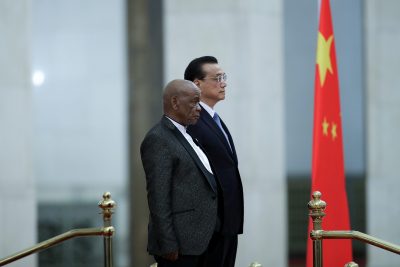Date: Friday, 19 October 2018
Author: David H Shinn, George Washington University
19 October 2018
Forum on China–Africa Cooperation (FOCAC) conferences have been held every three years since the first one in 2000. China has pledged significantly more funding at each successive FOCAC conference — until the one that ended in Beijing in early September 2018. This year, China announced a US$60 billion financial package for Africa, the same amount pledged at the previous FOCAC in Johannesburg in 2015.

The latest pledge is rather different than the one three years ago. In 2015, China designated US$5 billion for grants and interest-free loans; US$35 billion for preferential loans, export credits and concessional loans; US$5 billion for the China–Africa Development Fund, a private equity and venture capital investment arm of the China Development Bank; US$5 billion as a special loan for the development of African small and medium-sized enterprises; and US$10 billion as the initial capital for a China–Africa production capacity cooperation fund.
At the just concluded FOCAC, China pledged US$20 billion in new credit lines; US$15 billion as grants, interest-free loans or concessional loans; US$10 billion for a special fund for development financing; and US$5 billion for a special fund for financing imports from Africa. For the remaining amount, China will encourage Chinese companies to invest at least US$10 billion in Africa over the next three years.
Broken down like this, it becomes clear that China’s most recent financial package actually constitutes a decrease in the Chinese government’s commitment compared to 2015. One-sixth of the total is government ‘encouragement’ of Chinese companies to invest in Africa — foreign direct investment that would likely happen in any event. Adding this to the package looks like a way to get the total to US$60 billion so that China’s 2018 pledge does not appear to be less than the one promised in 2015.
The US$5 billion special fund for financing imports from Africa is a new and useful idea, but presumably will benefit Chinese importers. China now has a significant trade surplus with all of Africa and with the overwhelming majority of individual African countries. There is growing concern among African countries about their trade deficits with China. This fund could help to address these concerns while providing a secure source of natural resource imports for China in the process.
African indebtedness is another challenge. The International Monetary Fund has identified six African countries in debt distress and another 10 at high risk of debt distress. Many international financial institutions, commercial banks and foreign governments contribute to Africa’s external debt load. While Chinese loans are responsible for the majority of debt in several of these countries, China is often unfairly identified as the principal culprit across the continent. China too is concerned about the ability of African countries to repay these loans.
Reflecting this concern, the 2018 financial package reduced the amount for new loans. China also agreed to cancel the debt of Africa’s least developed and heavily indebted poor countries that have interest-free loans due to mature by the end of 2018. While this will help, most of China’s loans to Africa are concessionary and not subject to debt cancellation.
Another challenge is China’s domestic reaction to this large development assistance package for Africa. Chinese netizens argue that China is still a developing country where millions of Chinese live below the poverty line. China’s economy is experiencing a slow-down in retail sales growth and a moderately lower GDP growth rate. Chinese netizens believe this money destined for Africa should be spent in China to help Chinese people in need. Of course, it is not well understood that much of the funding stays in China because Chinese companies build the projects in Africa funded by government loans. Only a small part of the development package consists of grants.
Ultimately, the 2018 FOCAC dealt with much more than offering a US$60 billion funding package. Most significant was the effort to include the China–Africa relationship in China’s Belt and Road Initiative (BRI).
The BRI, except for the Maritime Silk Road’s links to northeast Africa and the Suez Canal, did not initially include Africa. Now China is bringing all of Africa into the BRI. Infrastructure projects that were agreed to and even under construction before Chinese President Xi Jinping’s 2013 announcement of the BRI are now considered part of it. The BRI is also taking on a security role in Africa by linking the initiative to China’s ongoing participation in UN peacekeeping operations and international efforts to combat piracy and terrorism.
The BRI seems to be China’s guiding policy for the FOCAC, but at this stage this is little more than China putting old wine in new bottles.
*David H Shinn is Adjunct Professor at the Elliott School of International Affairs, George Washington University.